Dell XPS 13 Review
by Brett Howse on February 19, 2015 9:00 AM EST- Posted in
- Laptops
- Dell
- Ultrabook
- Broadwell-U
- XPS 13
Gaming Performance
Normally on an Ultrabook we would not dedicate an entire page to gaming performance, because the integrated GPUs do not perform very well on our gaming tests. However, with this being our first example of Broadwell-U, it is a good time to revisit this and see how the new graphics capabilities of Broadwell compare to the Haswell processors.
With the Core i5-5200U in both of the XPS 13s that we received, we have 24 execution units, compared to only 20 on Haswell-U. In addition, the 14nm process should help with throttling. The FHD model (1920x1080) arrived with a two 2GB memory modules and the QHD+ version came with 2 x 4GB.
First, let's look at the synthetic benchmarks, starting with 3DMark and then moving on to GFXBench.
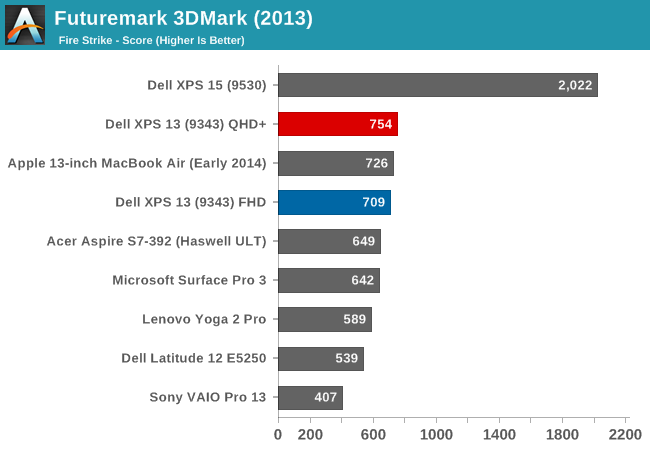
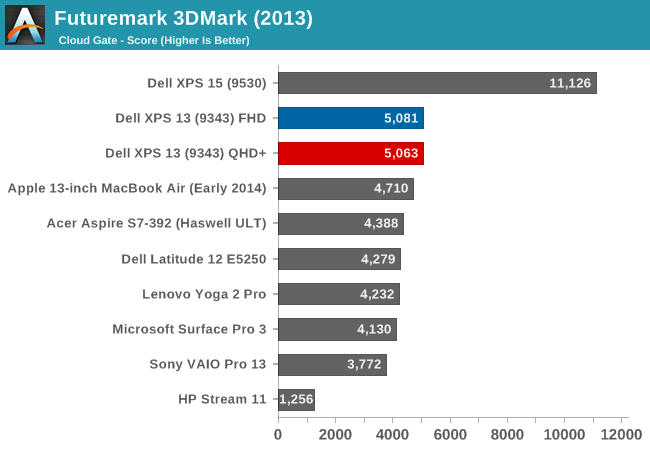
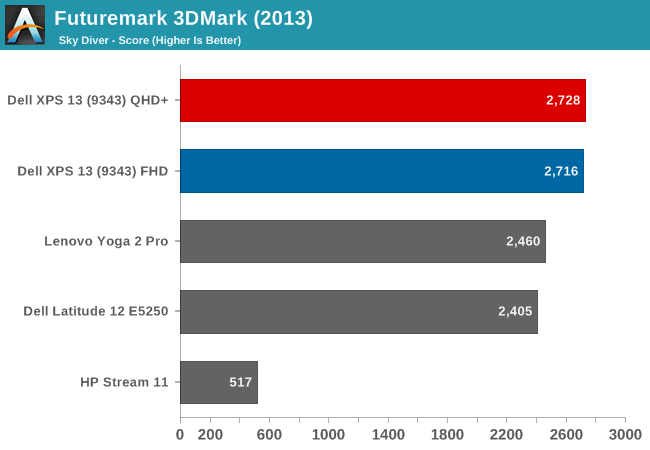

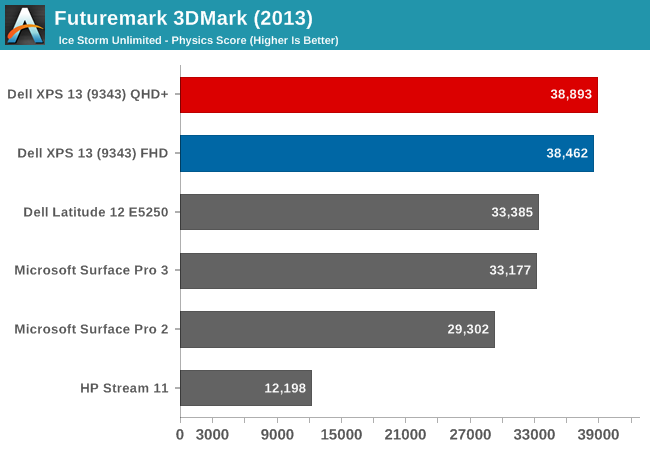
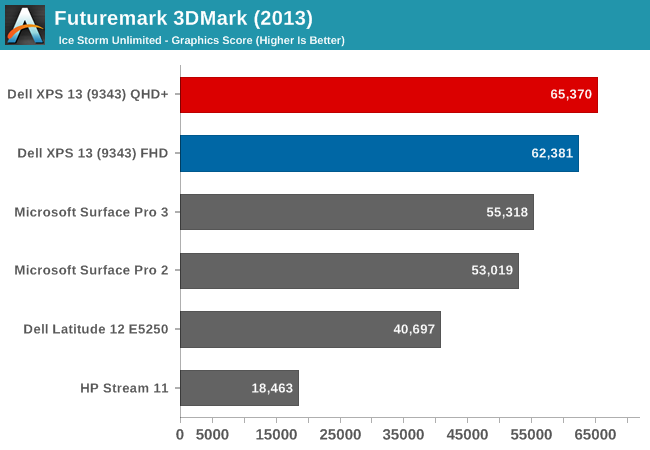
The 3DMark results begin to show the increased GPU performance of the Gen8 graphics. Broadwell-U outperforms all of the Haswell-U parts on all of the tests, and the QHD+ model gave a fraction more performance as well in a few tests.

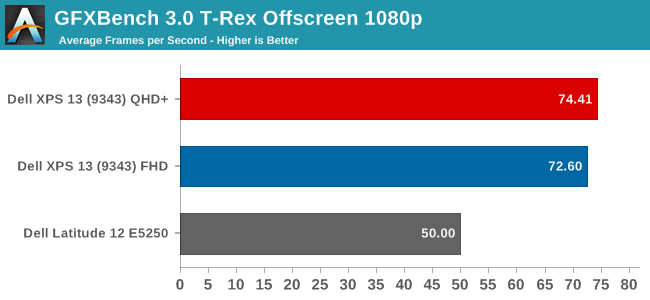

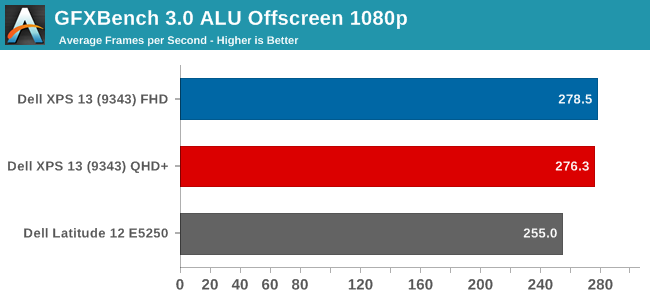
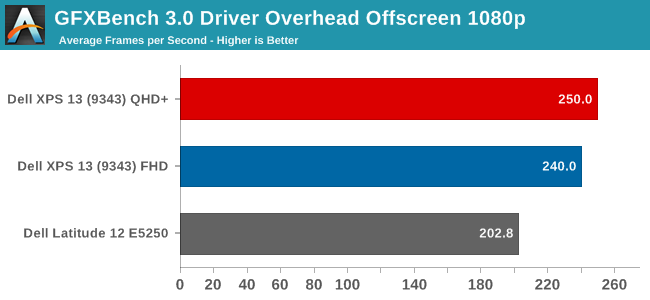
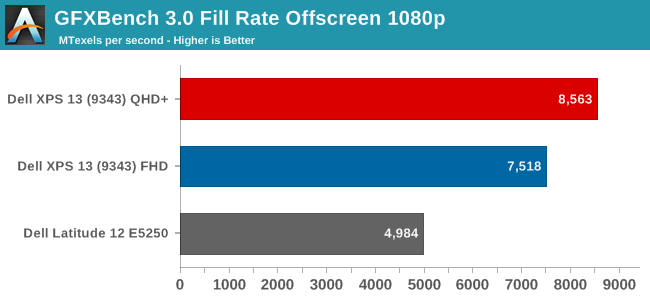
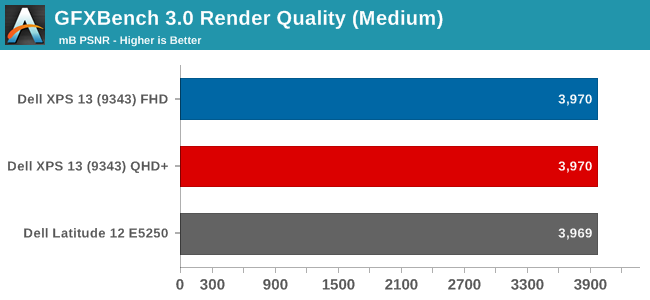
The initial results for the new GPU look pretty good, with the new GPU soundly beating the Haswell-U parts. The HP Stream 11, with just 4 EUs, trails quite far behind. GFXBench is one of our newer benchmark choices for Windows 8, and we will add more data as we get a few more devices to test.
Next, let's look at our gaming benchmarks. Due to the low performance of the integrated GPUs, I just ran our gaming tests at the Value (1366x768 ~Medium) settings.

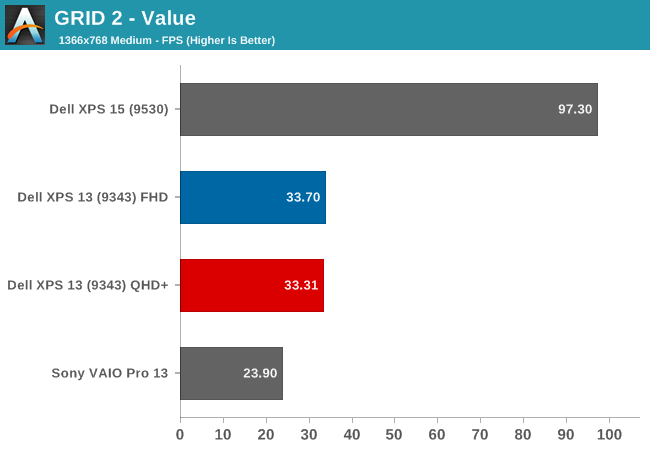

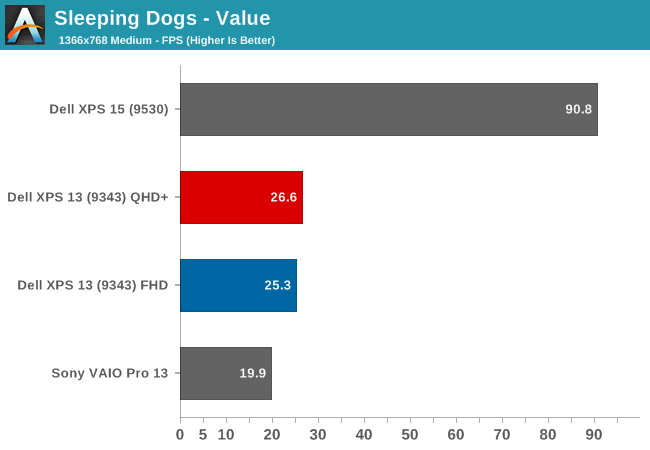
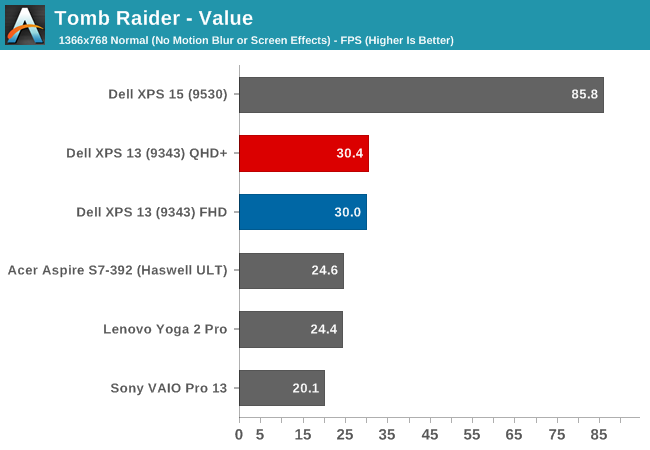
Here we can see once again that the new GPU is certainly stronger, but it is still not quite enough to make any of these games very playable on our Value settings. The Dell XPS 15, with its discrete GPU, carries a huge lead over the integrated GPU offerings. Still, the new Gen8 Graphics with more execution units per processor, as well as a change to the architecture of each execution unit, has made a healthy improvement. The new GPU has only eight EUs per sub-slice now, as compared to ten in Haswell-U, which help in many workloads. Ian has a nice writeup on the changes.
However, our gaming benchmarks are not tested at the lowest possible settings. All of the benchmarks start at 1366x768 with medium settings, so let's drop down another notch.
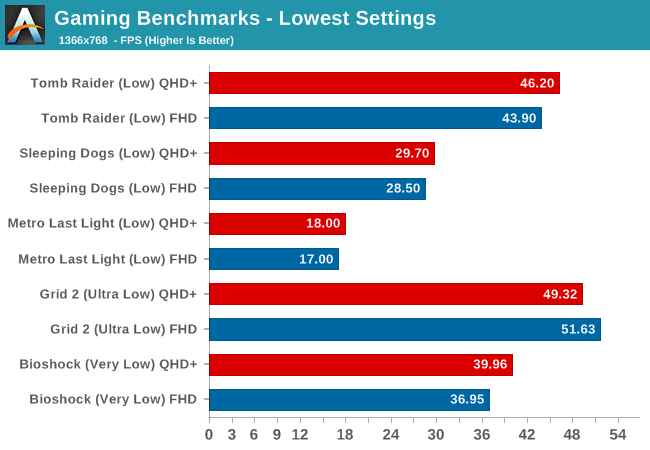
By setting the games to their lowest settings, some of them are now playable. We are still a long ways off of the performance of a discrete GPU, but slowly integrated graphics are improving.
Finally, we have a new gaming benchmark to add to our repertoire. Anand first used the DOTA 2 bench for the Surface Pro 3 review and it will be our go-to benchmark for devices like this without a discrete GPU. Our Value setting will be 1366x768 with all options off, low quality shadows, and medium textures. Midrange will be 1600x900 with all options enabled, medium shadows, and medium textures, and Enthusiast will be 1920x1080 with all options maxed out.
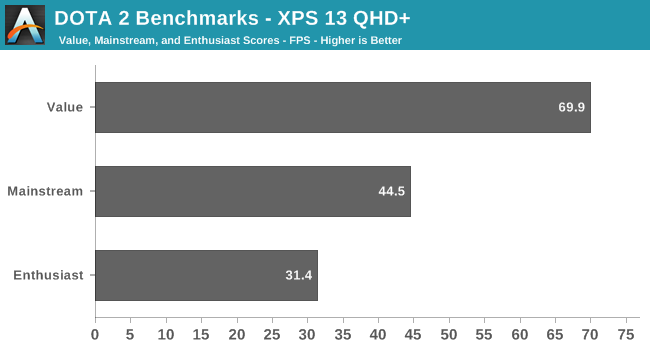
We do not have any other comparison points at the moment, but it is very clear that a game like DOTA 2 is very playable on a device with an integrated GPU. Frame rates, even with good settings, are very reasonable.
So Broadwell has raised the stakes again, but the end result is Intel's Integrated GPU is still not going to let you play AAA titles with good frame rates. Hopefully we can get some good comparisons between Broadwell-U and the AMD APUs in the near future. It will also be interesting to see what happens on the higher wattage Broadwell parts, some of which will contain significantly more EUs.










201 Comments
View All Comments
Stochastic - Thursday, February 19, 2015 - link
I’ve been using this machine for a few weeks now. My impressions so far are largely positive. Here are some things that would take this laptop from “Great” to “Unbeatable”:--Offer option to disable auto-brightness
--Improve display calibration of FHD model
--Use less aggressive anti-glare coating on FHD model
--Give more touchpad options for configuration
--Reduce tendency of fan to spool up when plugged in (this can be tweaked in software settings, however)
--Adjust position of webcam
--Add just a smidge more key travel (I wouldn’t mind a 1mm thicker device)
--Use a different material for keyboard such that smudging is less noticeable
--Reduce price of 256GB SSD/8GB RAM model by $100
--Provide option for touch display on the FHD model for $100 or less premium
If Dell made the above changes then this device would absolutely take the market by storm. As is, it’s still a very solid device in my opinion.
I will say that I’m not getting anywhere close to the battery life that Anandtech is reporting for the FHD model. I’ve read on forums that the CPU usage spikes up whenever the touchpad is used, so that might account for the disparity. It would be great if Anandtech could investigate this.
eddman - Thursday, February 19, 2015 - link
"I will say that I’m not getting anywhere close to the battery life that Anandtech is reporting for the FHD model."Do you mean web browsing battery life? If so, are you using chrome? If yes, then it could be the culprit. Last time I checked chrome used a bit too much power compared to IE.
Stochastic - Thursday, February 19, 2015 - link
Yeah, I am using Chrome. I feel crazy saying this, but I'm actually really looking forward to Microsoft's Spartan browser.ymcpa - Thursday, February 19, 2015 - link
Why would you say you feel crazy? IE has been a good browser for a while now and it is less resource intensive than chrome. It's funny that chrome started out as the light, simple alternative to IE and now it is the bloated one. The only reason to stay with chrome is if extensions are important to you and Spartan is reported to allow extensions.CaedenV - Thursday, February 19, 2015 - link
Ya, I use to swear by chrome a few years ago, but about 1.5 years ago I started having odd issues where it would slow my computer down and have odd rendering/graphical glitches. I tried FF again for a few months but really hate the changes they have been making to it. So now I have been using IE for the last year for lack of something better... and you know what? It pretty much works. I do miss some of the plugins that I use to have, but the privacy settings do a decent job at blocking most adds which is the big thing. Not saying that I have really fallen in love with IE, but for 90% of what I do it works great, and the other 10% I hold my nose and use FireFox.If not for the performance (and privacy paranoia) I would switch back to chrome in a heartbeat, but it simply is not as good as it use to be compared to the other options available.
mhonard - Friday, March 13, 2015 - link
I have the MS signature version with i5, 256gb, 8gb ram, QHD touch display and NOT running chrome. Light usage I'm only getting 6.5 hours of usage in balanced mode. I am using the touchpad exclusively. It would be nice to understand why I'm getting such a different result than Anadtech. This is a deal killer for the price I paid.Brett Howse - Saturday, March 14, 2015 - link
Could be lots of things really. What is your display set to for brightness? Display is a big draw. You are getting between our heavy workload and our light workload, so assuming your display is close to 200 nits, it could just be that your light workload is still a lot heavier than our light web browsing workload. File copies, network access, and other things can all contribute to a lot more power draw.First suggestion is to set the brightness lower as it will likely have the biggest impact. You can also try installing Battery Bar to see what kind of power draw you are pulling at any one time.
tipoo - Thursday, February 19, 2015 - link
Go to the windows 8 start screen and just type in brightness, the auto feature should be there to turn off? I don't have this model but that's how it worked on every win8 laptop I used.ymcpa - Thursday, February 19, 2015 - link
The article stated that there is no option to off the auto brightness setting and have asked Dell to respond. I'm sure it is something that can be fixed in a future firmware update.ymcpa - Thursday, February 19, 2015 - link
Not sure what more touchpad options mean. I bet the fan spools up when plugged in because the power setting are set for highest performance when plugged in. There is probably not much they can do with the web cam without increasing the bezel. I would suggest a flip up web cam that is hidden and you flip it up when you need it. Plus this will insure privacy since people won't be able to hack in to the laptop and access the web cam. The rest of your comments seem very doable.